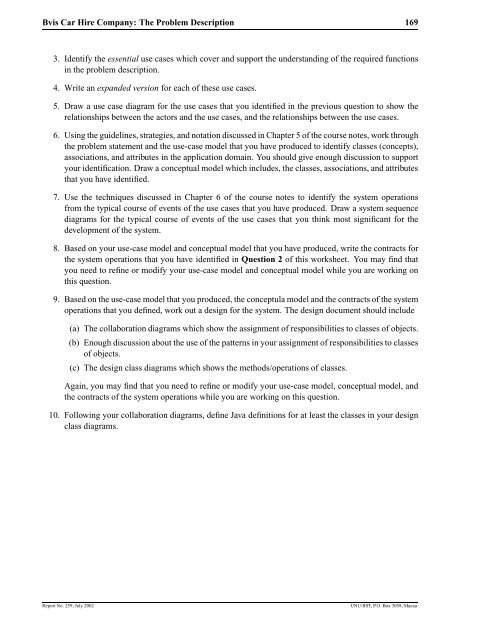Object-Oriented Software Development with UML - UNU-IIST ...
Object-Oriented Software Development with UML - UNU-IIST ...
Object-Oriented Software Development with UML - UNU-IIST ...
You also want an ePaper? Increase the reach of your titles
YUMPU automatically turns print PDFs into web optimized ePapers that Google loves.
Bvis Car Hire Company: The Problem Description 1693. Identify the essential use cases which cover and support the understanding of the required functionsin the problem description.4. Write an expanded version for each of these use cases.5. Draw a use case diagram for the use cases that you identified in the previous question to show therelationships between the actors and the use cases, and the relationships between the use cases.6. Using the guidelines, strategies, and notation discussed in Chapter 5 of the course notes, work throughthe problem statement and the use-case model that you have produced to identify classes (concepts),associations, and attributes in the application domain. You should give enough discussion to supportyour identification. Draw a conceptual model which includes, the classes, associations, and attributesthat you have identified.7. Use the techniques discussed in Chapter 6 of the course notes to identify the system operationsfrom the typical course of events of the use cases that you have produced. Draw a system sequencediagrams for the typical course of events of the use cases that you think most significant for thedevelopment of the system.8. Based on your use-case model and conceptual model that you have produced, write the contracts forthe system operations that you have identified in Question 2 of this worksheet. You may find thatyou need to refine or modify your use-case model and conceptual model while you are working onthis question.9. Based on the use-case model that you produced, the conceptula model and the contracts of the systemoperations that you defined, work out a design for the system. The design document should include(a) The collaboration diagrams which show the assignment of responsibilities to classes of objects.(b) Enough discussion about the use of the patterns in your assignment of responsibilities to classesof objects.(c) The design class diagrams which shows the methods/operations of classes.Again, you may find that you need to refine or modify your use-case model, conceptual model, andthe contracts of the system operations while you are working on this question.10. Following your collaboration diagrams, define Java definitions for at least the classes in your designclass diagrams.Report No. 259, July 2002<strong>UNU</strong>/<strong>IIST</strong>, P.O. Box 3058, Macau
















